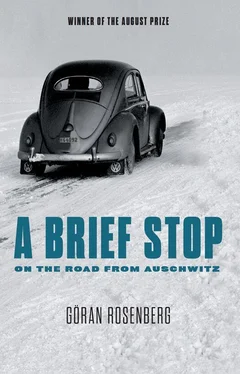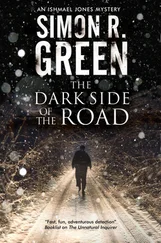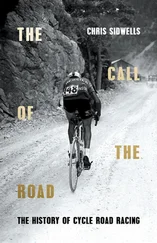I’ve grown used to the way Bertil walks, he walks as fast as I do, anyway, but I haven’t grown used to his stunted leg. I try not to stare at it, and not to listen to the thumping and rattling, but Bertil’s leg pains me. I never see that it pains him, and we never talk about it, but it pains me because it looks so painful. But then we read more than we talk, Bertil and I. Bertil’s two years older and lives on the first floor in the house next to ours along the rowanberry avenue, and he has his own room, full of books and comics. Bertil reads a lot and doesn’t go out to play all that much, which suits me fine.
But every now and then we do go out. One day we go to the swings in the playground under the pines, behind the Co-op. Bertil likes swinging on the swings. He swings a bit the way he walks, twitching and lurching, as if the upper part of his body can’t adapt to a weightless state.
There’s an elderly man sitting on a bench in the park, staring at Bertil’s leg. “Go home and have some bilberry soup so you’ll grow strong and healthy,” the man says.
Bertil doesn’t reply, just keeps on swinging, perhaps a bit more jerkily.
“I suppose you’ve heard that bilberry soup cures polio? It takes a lot of soup, though. At least two bowls a day.”
Bertil pretends not to hear but my ears prick up, because I know Bertil’s stunted leg is caused by polio. Polio’s an incurable disease you can die of. There’s nothing to say about polio because there’s nothing to be done. We both know that.
Bilberry soup! And no one thought of that before, imagine.
I rush over and grab Bertil’s swing.
“Did you hear that?”
Yes, Bertil has heard.
We walk back home.
We say no more about bilberry soup.
Neither of us says anything at all.
The only sound is the thump of his shoe, the creak of the splint, and, I seem to recall, a faint sighing in the pines.
For a long time I remain convinced that bilberry soup must be tried. Could I get a few bowls of bilberry soup into Bertil without him noticing? Could Mom give Bertil some bilberry soup and call it something else? After all, cabbage soup is called kapusta in our home, and chicken soup is rossu . I fantasize about how one day Bertil, filled with bilberry soup called by another name, gets up from our kitchen table and slowly takes off his splint and looks at me with astonishment and gratitude in his gray-blue eyes.
I still have a child’s incapacity to distinguish between what’s possible and what’s not.
I’m also the child of a time when so much that only recently was said to be impossible is now said to be possible, almost a matter of course, in fact.
So why not bilberry soup?
In that respect, it’s a bright time to be a child.
So much darkness that will soon be dispelled.
The light shining in polio’s darkness is a bright, pinkish-red liquid. The syringe for the polio injections is big and terrifying, but the color’s inviting and comforting. The polio vaccine won’t do anything for Bertil’s leg, I realize, but the mystery of polio has been solved, so they say. There are many mysteries that are soon to be solved in the years when I’m making the world my own. Once the polio mystery is solved, the cancer mystery will be, too. “Cancer” is one of those words of darkness, like “polio.” The demons of polio thrive in piles of earth and unboiled water. The polio virus is killed by a pinkish-red liquid injected into your body. In the newly built school of pale yellow brick, the school nurse’s room is an antiseptic temple of white plastic and shiny stainless steel. We’re sent there one class at a time for a resolute jab in the tops of our bared arms, meant to bless us with a future from which darkness has been banished.
It’s not only polio and cancer that will soon be eradicated, but malaria and tuberculosis, smallpox, measles, and the common cold.
Perhaps pain, too.
Perhaps even war, but that seems a taller order.
“Exterminate” is a word of light, strangely enough. Until very recently, the extermination of human beings was literally darkening the skies, which should have made the very word a word of darkness, should in fact have rendered it all but unusable, but in the world of polio injections there are still things that can and should be exterminated, like weeds or pests. Poor hygiene also needs eradicating, which is merely a matter of time in the apartment blocks by the rowan avenue, where all the apartments have bathtubs and flushing toilets and the garbage trucks have mechanisms for spill-free emptying and the people are starting to perfume their underarms with something they call deodorant, which goes by the name of Mum. “Mumming,” they call it. I don’t start mumming until much later, when I realize that the smell of sweaty armpits is a sign of poor hygiene.
Paradoxically, it’s the successful combating of poor hygiene that in the twentieth century transforms polio from a benign childhood illness causing a temperature and a headache into a nightmare epidemic that paralyzes the nervous system. The virus is spread through excrement, and better toilet hygiene reduces the incidence of it, but better toilet hygiene also reduces the resistance to the virus and increases the risk that older children and adults with little resistance will fall victim to a life-threatening form of the virus. The advances in hygiene that work so successfully on cholera, typhoid, and diphtheria do not work on polio but actually make it more dangerous.
However, no mystery with no solution. Polio is almost eradicated now, and the battle against lack of hygiene is soon to be won. Not to mention the battle against weeds and pests, waged daily behind the fence in the forest between Havsbadet and the rowanberry avenue. The fence is marked with black-and-yellow skull signs. Inside the fence there’s a factory. Between the fence and the factory building, there are barrels with white skulls painted on them. Outside the fence, on the paths through the forest, there are dead rats, sometimes gnawed rat skulls. The factory isn’t situated along the footpath to Havsbadet but along a side path leading under a railroad viaduct to the other side of the embankment. Around the factory, a pungent smell of acid and decay. There’s a damp, cold draft under the viaduct, and it’s always dark, and on the way home I keep running until I get a glimpse of the houses along the rowan avenue.
I run as if I’m only playing, so no one will know how petrified I am.
The factory behind the fence with the skulls is called Ewos and manufactures products for the extermination of all kinds of things that get in mankind’s way. “Chemistry reclaims farming for the farmers,” say the advertisements in the local paper. “Parasites” is a recurring word. Parasites infesting animals and crops are getting in the farmers’ way, “microorganisms gobbling up hard currency” are getting in the way of paper and wood manufacturers, and in the barrels with the skulls there are, I assume, things that could kill not only parasites and microorganisms but also playing children from the houses on the other side of the embankment, and the danger needs to be signaled in some visual way. The parasites to be killed have names like cabbage seed weevil, pollen beetle, brassica pod midge, wheat blossom midge, and clover cutworm, and the preparations designed to kill them have names like Arsenol, Pyrenon, Rotoxol, and Ewotox, and they’re all rendered more effective by being sprayed from the air. Ewos’s handbook for growers and breeders is titled Death of the Millions .
I read in the local paper (much later, I admit) that the factory site is somewhat problematic in the sense that drainage for the plot on which the barrels are stored has to be routed through a culvert under the railroad embankment in order to run out where it should, into the sea by Igelstaviken, which is part of the deep, saltwater bay on which Havsbadet lies, with its soft sand and creaky diving tower. That in turn requires “the excavation of an open ditch to a maximum depth of 2.70 meters and a length of 260 meters” because the drainage is so poor. This is in December 1951, and the town finance office applies to the town council for 13,500 kronor to underwrite the project.
Читать дальше












